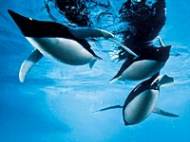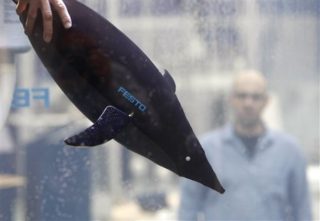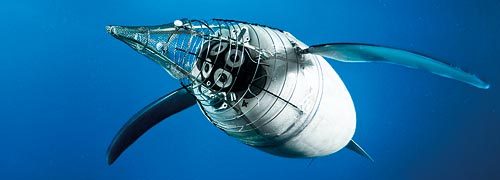Festo AquaPenguin inovates autonomous underwater vehicles
 Besides being cute, penguins are amazingly good swimmers. In their search for food, penguins often travel more than a hundred kilometers per day; they are able to dive in depths up to 700 meters. They are fast n the water, have a great deal of endurance and are astoundingly agile and can reach a top speed of almost 30 kilometers per hour. Those facts inspired German company Festo to make the AquaPenguin.
Besides being cute, penguins are amazingly good swimmers. In their search for food, penguins often travel more than a hundred kilometers per day; they are able to dive in depths up to 700 meters. They are fast n the water, have a great deal of endurance and are astoundingly agile and can reach a top speed of almost 30 kilometers per hour. Those facts inspired German company Festo to make the AquaPenguin.
Haulage tests with cast models of the spindle-shaped penguin’s bodies show a flow resistance 20 to 30 percent lower than the hydro-dynamically most favorable known technical bodies (cd-values < 0.02, with Reynolds numbers in the order of 106). The elastically deformable wing surfaces also make for high thrust efficiency. These two factors combine to yield a surprisingly low energy consumption level. Investigations of the metabolism of living penguins in a specially built swimming tunnel in Antarctica have revealed that Adélie penguins, for example, can swim more than 180 kilometers on a full stomach (approx. 1 kilogram of krill). If the penguins’ bodies were operated with petrol, they would thus be able to travel some 1,500 kilometers through the icy Antarctic waters on just one liter of fuel.
These phenomenal feats from the animal kingdom provided the inspiration for the bionic realization of the AquaPenguin which is, as its authors say technology-bearer of autonomous underwater vehicles.
The bionic penguins are designed as autonomous underwater vehicles (AUVs) that independently orient themselves and navigate through the water basin and develop differentiated, variable behavior patterns in group operation. The penguins’ hydrodynamic body contours and elegant wing propulsion principle were adopted from their natural archetypes. The wings comprise a skeleton of spring steel elements embedded in an elastic matrix of silicon that gives them their profile; they can thus twist to an optimal angle in interaction with the hydrodynamic forces in each stroke, whereby the pitch angle can also be regulated interactively. The robotic penguins can thus maneuver in cramped spatial conditions, turn on the spot when necessary and – unlike their biological archetypes – even swim backwards.
An entirely new feature in robotics is the torso that can move in any direction. To make such an “organic” change of shape possible, the head, neck and tail segments were based on a new 3D Fin Ray structure. This structure, derived from the tail fin of a fish, has thus been extended into three-dimensional space for the first time. In the realization selected here, the bending structure consists of flexible longitudinal struts with circumferential connecting elements that maintain the shape of the elastic skin. Steering is effected via the longitudinal struts and mechanically linked draw lines, with small actuators for horizontal and vertical movement. The actuators and control electronics are housed in the dry chamber of the torso.The shoulder joints are spherical; the wing axes pass through the joints and are also fitted with separately bearings which are able to rotate within the sphere. The additional axis of rotation is controlled by one actuator per wing, which adjusts the wings’ pitch angles. This mechanism is used for steering in various maneuvering situations. A special flapping mechanism acts on the wing axes directed toward the torso, in order to operate the two wings synchronously and to provide the strong up-and-down motion for propulsion.
This force is provided by one powerful electric motor, whose rotational speed also controls the flapping frequency of the wings; the forces are transferred to the wings by means of a leverage system fitted with a further actuator, which by slightly displacing the pivot points can modify the effective length of the lever arms and thus also the transmission ratio; this in turn regulates the amplitude of the flapping wings.
The entire mechanism is designed in such a way that in conjunction with the elastic wing twist, the kinematics of the penguins’ underwater “flight” is imitated almost perfectly, the flapping cycles are practically a self-regulating automatism, and maneuvering is effected using only a minimum of effort.
In order to analyze their surroundings, the AquaPenguins are fitted with special 3D sonar which makes use of broadband ultrasound signals, similar to those used by dolphins and bats. This enables them to determine their spatial position, constantly measure the distances to the walls of the water basin, avoid collisions and navigate autonomously. A separate pressure sensor is also available for operation at greater depths in free water.
Some of the movement patterns have been combined into programmed elementary maneuvers. The further processing is carried out by the intelligent onboard electronics that allow the penguins to navigate autonomously and to develop versatile patterns of interaction with the other members of the group.
The bionic penguins readily demonstrate what is meant by learning from nature. The use of innovative technical materials and the creative combination of various design and functional principles pave the way for new opportunities in design and automation technology. The penguins’ torso design can be used in automation for flexible tripods, thereby opening up new fields of application in handling technology. The BionicTripod has an operating range that by far transcends that of the conventional tripod configuration; for example, pick-and-place applications with an offset of 90 degrees are possible.
In combination with a flexible and adaptive gripper, fragile objects of various shapes can be moved. With the AquaPenguin, Festo is benefiting from the advantages of versatile contour and structural adaptation and intelligent self organization, both on an individual level and in group operation. Intelligent sensors are also opening up new applications. Thanks to its rapid, precise control, the AquaPenguin can swim collision-free in group operation, with depth control, pressure and temperature compensation, and positional stability. Transfer to automation technology is also to be found in the regulation technology of Festo, for example in the new VPPM and VPWP proportional-pressure regulators for servo-pneumatics.











Hi!my name is peyman i have a sicentific group that search on the sea animal!the goal of this group is to creat a sea machine for enjoying the peopel!
I search about penguin and i must analyze the swimming of the penguin but i can’t find the any paper of this course now i need your help and i want that if you have any paper about how penguin swim or analyze the swimming of penguin please sent to my mail
donde se hicieron estos pinguinos mas informacion